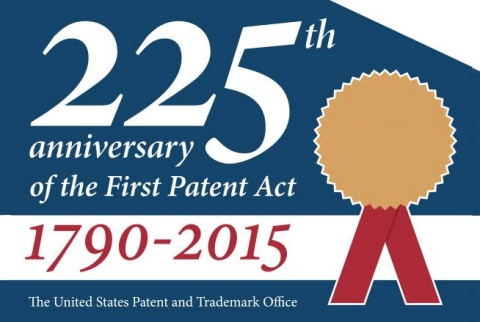Apr102015
Posted at 11:26 AM
Today, the United States Patent and Trademark Office (USPTO) commemorates the 225th anniversary of the Patent Act. Enacted on April 10, 1790, the Patent Act expanded upon the progress clause in Article I, Section 8 of the U.S. Constitution which promoted “the Progress of Science and useful Arts, by securing for limited Times to Authors and Inventors the exclusive Right to their respective Writings and Discoveries” by further defining the subject matter of a patent as “any useful art, manufacture, engine, machine, or device, or any improvement thereon not before known or used.”
Rooted in British common law and European history, the limited term of that “exclusive right”—as a patent, copyright or, later, a trademark—was, much like the Constitution itself, a judicious balance, one that could provide an incentive for invention and disseminate knowledge while also guaranteeing that others could, after an appropriate period of time, freely incorporate these “Writings and Discoveries” for their own purposes of creativity and innovation.
Signed by George Washington, the Patent Act set forth a continuous advance in science and technology that only gained momentum with each generation. It laid the groundwork for more than two centuries of cumulative or follow-on innovation for the benefit of all.
The impact of cumulative innovation can be seen in the myriad forms of laser technology we enjoy today, beginning in 1917 with Albert Einstein, the first to theorize the process of “stimulated emission.” But it wasn’t until 1954 that Charles Townes and Arthur Schawlow turned theory into practice with their invention of Microwave Amplification by Stimulated Emission of Radiation, or maser, using ammonia gas and microwave radiation, for which they were granted U.S. Patent 2,929,922 in 1960.
Publication of their findings in 1958 generated a race among researchers and innovators to build the first laser. Gordon Gould, a student of Townes’, built the first optical laser in 1958. In 1960, Theodore Maiman invented the ruby laser and Ali Javan the first gas laser. In 1962, Robert Hall invented the semiconductor injection laser, which is still used in many electronic appliances and communications systems. Gary Starkweather invented the laser printer in 1969. And in 1981, Samuel Blum, Rangaswamy Srinivasan, and James Wynne co-invented a process using a short pulse ultraviolet laser to etch tissue in minute increments and in a highly controlled fashion. Gholam Peyman improved upon their discovery in his invention of LASIK eye surgery, patented in 1989.
In his 2002 autobiography, “How the Laser Happened: Adventures of a Scientist,” Townes wrote that the “development of the maser and laser, and their subsequent applications in my career and in science and technology generally, followed no script except to hew to the nature of humans groping to understand, to explore, and to create.” Over that same period of exploration and creation, more than 55,000 laser-related patents were granted in the United States.
Those same patents have generated billions of dollars of business since 1960, through licensing fees and the many laser-based products created in the lab, manufactured at home and abroad, and sold and employed for the benefit of consumers in the marketplace. The “exclusive right” guaranteed in the progress clause of the U.S. Constitution made that possible. It provides companies an incentive to innovate in the knowledge that a patented invention can not only help them recover the costs of research and development, but allows them to reap profits from licensing and sales that can in turn fund more innovation, while simultaneously disseminating the information needed for others to explore, create, and improve upon previous patented technology.
But for scientists like Townes, the thrill of discovery and creation will always be a compelling incentive of its own, not to mention the recognition of their achievements that survive long after they’re gone. In addition to several Nobel Prizes, many of these pioneers of patented laser technology have since been inducted into the National Inventors Hall of Fame. They include Charles Townes (1976); Theodore Maiman (1984); Gordon Gould (1991); Robert Hall (1994); Arthur Schawlow (1996); Samuel Blum, Rangaswamy Srinivasan, and James Wynne (2002); Ali Javan (2006); and Gary Starkweather (2012).
Blum, Peyman, Srinivasan, and Wynne were also recipients of the National Medal of Technology and Innovation, the nation’s highest honor for technological achievement, administered by the USPTO on behalf of the Department of Commerce.
“I am proud to honor these inspiring American innovators,” President Obama said, in awarding the medals in early 2013. “They represent the ingenuity and imagination that has long made this nation great—and they remind us of the enormous impact a few good ideas can have when these creative qualities are unleashed in an entrepreneurial environment.”
“Fostering the creative and entrepreneurial environment that made the evolution of the laser—and so many other technologies—possible, remains the central promise of the Patent Act of 1790 and the progress clause of our Constitution,” said Under Secretary of Commerce for Intellectual Property and Director of the USPTO Michelle K. Lee during a commemoration ceremony at the USPTO headquarters in Alexandria, Virginia. “And ensuring that our nation’s patent laws continue to spur that kind of innovation remains one of the key missions of the United States Patent and Trademark Office, now in its third century of existence.”


